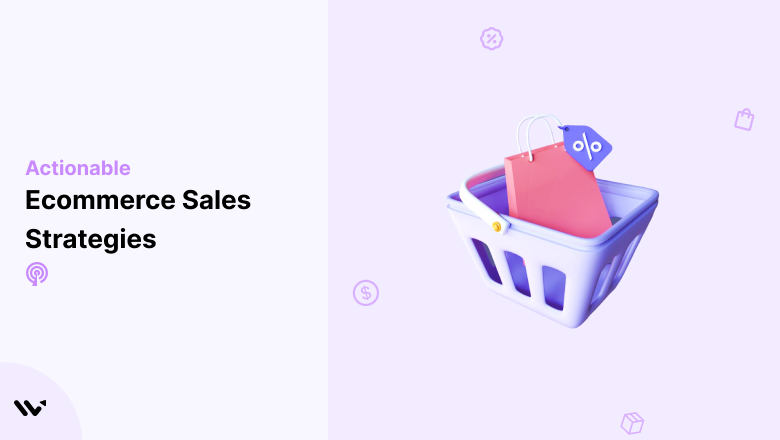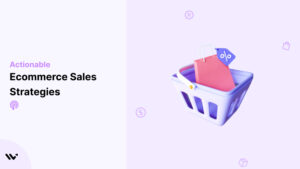Running an eCommerce store can feel overwhelming, especially if sales aren’t where you want them to be. You’ve got best products, and people are visiting your site but not buying for some reason.
A seamless customer experience is the key element for increasing eCommerce sales.
Small, simple adjustments can lead to big improvements in your eCommerce sales. We reviewed many successful online businesses and have compiled a list of proven Ecommerce sales strategies that you can follow for success.
In this post, we’ll discuss 15 powerful strategies to increase eCommerce sales.
Role of customer experience in eCommerce store
Customer experience (CX) is the foundation of a successful eCommerce store.
Customer experience is central to increasing eCommerce sales because it shapes how customers feel about your brand at every interaction, from browsing to purchase to post-sale support. A positive CX builds trust, encourages loyalty, and makes shoppers more likely to buy.
Critical aspects like responsive customer service, personalized recommendations, fast delivery, and easy returns all contribute to a seamless experience. When customers feel valued and supported, they’re more likely to return, buy more, and recommend your store to others—driving long-term sales growth.
Visitors leave your website without taking action?
They don’t trust your site or feel urgency to act. WiserNotify builds both, turning doubt into action & visitors into customers.
How to Increase Ecommerce Sales In 2025
Here are 15 tested ecommerce sales strategies you must follow.
1. First, make a winning sales funnel
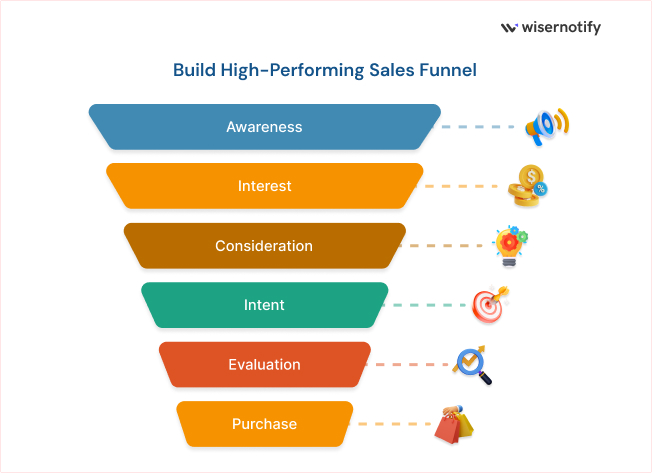
Your sales funnel is the journey your customers take from when they first learn about your brand to when they purchase. Optimizing each stage of the funnel can increase sales by reducing drop-offs and converting more buyers.
Improving your sales funnel means guiding visitors through each stage—from awareness to purchase—with fewer drop-offs.
Focus on attracting relevant traffic, capturing leads, nurturing them with valuable content, and simplifying the buying process. A streamlined funnel will increase your eCommerce sales.
Read More: 15 Latest eCommerce Growth Strategies Must Use In 2025
2. Simplify product discovery in eCommerce store
The faster your customers can find the products they want, the more likely they are to make a purchase. A user-friendly website with intuitive product search features can dramatically improve conversions by enhancing the experience for website visitors.
Good navigation is essential for helping visitors browse and locate items quickly.
- Use clear categories and subcategories to break down your products into logical categories and subcategories. For example, instead of just “Men’s Clothing,” you could have subcategories like “T-Shirts,” “Jackets,” and “Shoes.”
- Implement a sticky navigation bar that stays visible as users scroll through the site. This will allow them to switch categories without returning to the top.
- Include breadcrumb navigation to show users where they are on your site and let them easily backtrack.
- Use autocomplete predictive search suggestions that product suggestions pop up as users type in real-time. This can reduce the effort needed to find specific items.
3. Create impressive product descriptions and copy
An impressive product description can differ between a visitor bouncing off your site and becoming a customer.
The way you describe your products plays a huge role in whether shoppers feel confident enough to buy.
Well-written, persuasive copy doesn’t just describe your product—it sells it.
Customers don’t just want to know what your product does; they want to know how it will improve their life. That’s why it’s essential to go beyond listing features and focus on their benefits.
Example:
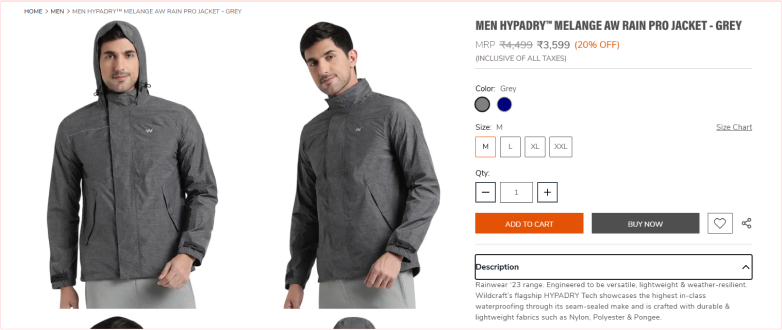
Instead of just saying: “This jacket is waterproof.”
Say: “Stay dry and comfortable, no matter how heavy the rain gets, with our 100% waterproof jacket.”
Here, you’re transforming a dry feature into a relatable benefit that addresses a customer’s problem (staying dry in the rain). The benefit highlights the solution your product offers.
Quick Tip:
Use this formula for your descriptions: Feature + Benefit + Solution
Feature: This phone has a 12-hour battery life.
Benefit: You can go all day without worrying about recharging.
Solution: Stay connected wherever you are, whether you’re traveling or at work.
Following these tips will help you create product descriptions that inform and persuade. Start implementing these strategies today, and watch your conversions soar!
Check Out: How to Use UGC Ads to Grow Your Brand
4. Add UGC content to build trust
User-generated content is one of the most powerful tools for customer engagement and can quickly increase eCommerce sales. When potential customers see real people using and loving your products, it builds trust and influences purchasing decisions.
User-generated content includes any form of content—like reviews, photos, videos, or testimonials—created by your customers rather than your brand. UGC acts as social proof, showing that others have purchased and enjoyed your product.
- Highlight customer reviews on product pages. Include star ratings and written feedback from real customers.
- Send post-purchase emails asking customers to leave reviews about their experience.
- Respond to positive or negative reviews to show that you value customer feedback.
- Encourage customers to upload photos directly to your store or share them on social media using a branded hashtag.
Learn More: 9 Powerful UGC Platforms to Grow Your Business in 2025
5. Offer discounts, coupons, and special promotions
Offering discounts, coupons, and special promotions is one of the most effective ways to increase e-commerce sales. These tactics create urgency, attract price-sensitive shoppers, and encourage customers to complete their purchases.
Here, you know strategies and implement them to increase ecommerce sales.
- Run short, time-sensitive promotions like “48-Hour Flash Sales” or “Weekend-Only Discounts.” Clear the time limit using countdown timers on your product pages that increase purchase count quickly.
- Offer discounts for holidays or events like Black Friday, Christmas, or end-of-season sales. Customers are more likely to shop when they associate your deals with special occasions.
- Offer a coupon code for new customers, such as “Get 10% off your first order.” Display this code in a prominent place on your website, like a pop-up or banner.
- If a visitor is about to leave your site without purchasing, trigger a pop-up offering a discount code. For example, “Wait! Save 15% when you complete your order today.”
- Offer bundled pricing on related products, such as “Buy two, get one free” or “save 20% when you bundle these items.”
- Encourage larger purchases by offering a discount for buying in bulk. For instance, “Get 10% off when you buy three or more.”
- When customers add a product to their cart, offer a discount on complementary items. For example, “Add this matching accessory for 15% off.”
- Reward your loyal customers with points or discounts for repeat purchases. Set up a system where customers can earn points for every purchase, which can be redeemed for discounts or free products.
Quick Tips
Place banners or pop-ups on your website promoting current discounts or special offers. Make sure they are apparent without disrupting the shopping experience.
6. Collaborate with an Influencer

Influencer marketing is a trending e-commerce marketing strategy. Collaborating with influencers is a proven way to reach a wider audience.
Influencers have built trust with their followers, making their recommendations highly impactful.
- Choose an influencer who aligns with your brand’s values and speaks to your target audience. Micro-influencers (10K–50K followers) often have strong engagement rates and can be especially effective for niche products.
- Provide the influencer with a special discount code for their followers. This will not only encourage purchases but also help you track the sales driven by the campaign.
Collaborating with the right influencer can introduce your brand to a trusted audience and drive real results in sales.
Also See : 10 Impactful eCommerce Marketing Automation Strategies
7. Do more product visible with SEO
Effective SEO (Search Engine Optimization) is essential for making your products visible to potential customers.
Correct SEO strategies can help your products appear higher in search engine results.
These SEO tips, from keyword optimization to technical tweaks, will help ensure your products rank higher and reach a wider audience.
- Use target keywords that customers will likely use when searching for your products. For example, instead of just “Men’s Shoes,” a better title would be “Men’s Black Leather Dress Shoes – Formal Wear.”
- Don’t use the same product descriptions across multiple product pages, as search engines may penalize duplicate content.
- To improve load times, reduce the number of elements on each page, such as scripts and images.
- Use product schema markup to include details like price, availability, and reviews directly in the search results. This can increase click-through rates (CTR) by making your product listings more attractive and informative.
- Include relevant keywords in the alt text of your product images.
- Create an image sitemap to help search engines index your product images, increasing the chances of your images appearing in Google image search results.
- Ensure your URLs are concise and include target keywords. For example, use “/mens-leather-dress-shoes” instead of “/product12345.”
- Breadcrumb navigation helps search engines and users understand your site’s hierarchy, improving SEO and usability.
Content marketing helps improve SEO by driving organic traffic and giving search engines more to index.
- Create blog content around your products, such as “How to Choose the Best Winter Jacket” or “Top 10 Running Shoes for 2025.” Include internal links to your product pages.
- Add a frequently asked questions (FAQ) section targeting common search queries on product pages. This will enhance user experience and provide SEO value by including long-tail keywords.
Pro Tips
Businesses selling digital products or services can attract visitors by offering an eBook, guide, or exclusive content in exchange for an email address.
8. Create converting exit-intent pop-ups
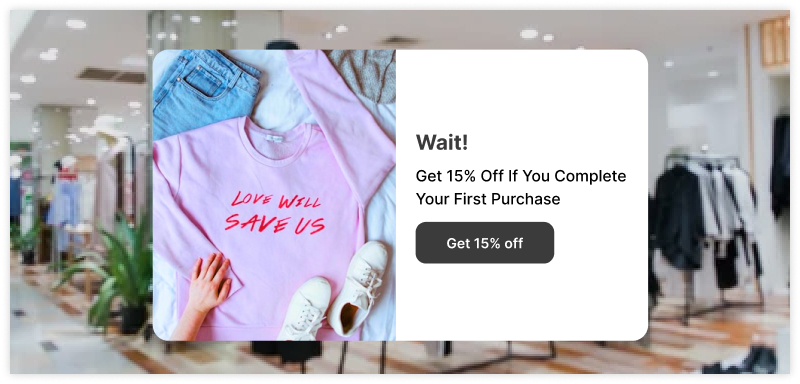
Exit-intent pop-ups are an incredibly effective tool to stop customers from leaving your site without making a purchase.
Exit-intent technology detects when a user is about to leave your website and triggers a pop-up offering an incentive to stay.
To capture a visitor’s attention before they leave, you need to offer something valuable that encourages them to stay or complete their purchase:
- Offer a discount, such as Get 10% off if you complete your order now or Grab an extra 15% off your first purchase.
- If visitors see pop-ups every time they visit your site, they may become frustrated and leave. Set limits on how often the same user sees your pop-up.
9. Run paid advertising
Running paid advertising is one of the fastest and most effective ways to increase eCommerce sales. Paid ads allow you to target specific audiences, showcase your products to more people, and drive immediate traffic to your store. Your ad creative will grab your target audience’s attention and encourage them to click.
Here’s how to get the most out of your paid advertising campaigns.
Not all ad platforms are the same, and the best one for your eCommerce business depends on where your audience spends their time.
- Google Ads is a top choice for search intent-based ads. Facebook offers robust targeting options, allowing you to reach audiences based on demographics, interests, and behaviors. Instagram is a highly visual platform perfect for promoting lifestyle products, fashion, home decor, and more. With features like Shoppable posts, users can purchase products directly from the platform.
Leverage Retargeting Ads
Retargeting ads are one of the most powerful tools for converting visitors who didn’t purchase their first visit.
- If users add items to their cart but don’t complete the purchase, serve them retargeting ads reminding them to finish checking out. Offering a discount in the ad can be a great incentive to bring them back.
- Target visitors who viewed a product but didn’t add it to their cart. Showing them the same product in retargeting ads can remind them of their interest and encourage them to return.
Check Out: 7 Smart Ways to Make Shoppers Trust Your Online Store
10. Display upsell and cross-sell products effectively
Upselling and cross-selling are two of the most effective strategies for increasing eCommerce sales quickly. They encourage customers to buy more than they originally intended.
By strategically displaying related products or upgrades, you can boost the average order value (AOV) and improve the customer experience.
Both strategies can be implemented throughout your site—on product pages, in the shopping cart, and even during checkout—to maximize effectiveness. This become a proven ecommerce sales strategy.
The best place to introduce upselling is on the product pages, where customers are already considering a purchase:
- Tag your upsell product as “Best Value” or “Customer Favorite” to subtly encourage the customer to choose the more expensive option.
- Show a “Frequently Bought Together” section featuring commonly purchased products.
- Use data from previous customer behavior to offer personalized cross-sell suggestions based on what similar buyers have purchased.
- At checkout, recommend small, useful add-ons like accessories or services (e.g., gift-wrapping or faster shipping options) that complement the customer’s purchase.
11. Add social proof pop-ups

Social proof pop-ups are real-time notifications that show recent customer activity on your site, such as recent purchases, product reviews, or customer sign-ups
These pop-ups create urgency by demonstrating that others actively engage with your products, encouraging new visitors to purchase sooner.
- Shows real-time notifications of recent purchases made by other customers.
- Displays the number of active visitors currently viewing the same product or page.
- Shows products currently trending or in high demand based on recent purchases or visitor activity.
12. Do best social media marketing
Day by day, social media is becoming the most popular platform for selling photos and videos because users can easily see exciting photos and videos. So, It is one of the most influential and budget-friendly ways to increase eCommerce sales.
With billions of active users across platforms like Facebook, Instagram, TikTok, and Pinterest, social media offers a massive opportunity to showcase your products and engage with potential customers.
Visual content is key to capturing the attention of potential customers on social media. Here’s how to present your products in the best light:
- Invest in professional product photography and videos with attractive content that showcases your products.
- Influencer marketing is a powerful way to reach a larger, engaged audience by partnering with individuals who have built trust with your target customers:
- Partner with influencers on an affiliate basis, allowing them to earn a commission for every sale they generate. This can incentivize them to promote your products regularly.
- Respond to customer questions, comments, and direct messages (DMs). Answering quickly and thoughtfully builds trust and encourages purchases.
- Build a community around your brand by starting conversations and asking for feedback from followers.
Run Targeted Social Media Ads
Organic reach on social media has limits, so running paid ads can significantly boost your eCommerce sales.
- Facebook’s and Instagram’s powerful ad targeting tools allow you to reach specific audiences based on interests, behaviors, demographics, and past interactions.
- Dynamic ads automatically show relevant products from your catalog to users who have already expressed interest in them.
Social media isn’t just a broadcasting tool—it’s a two-way communication channel. Engaging with your audience can strengthen connections and trust.
13. Enable in-app shopping
Enable in-app shopping means allowing users to browse, select, and purchase products or services directly within an app, without needing to leave the app or visit a separate website.
Allowing customers to browse and purchase directly within an app enhances the shopping experience by creating a seamless process that doesn’t require them to leave the app or navigate external websites.
This feature enhances the user experience by streamlining the shopping process. It often reduces friction and increases conversions, as customers can complete their transactions in a single, seamless flow within the app.
14. Use push notifications and text SMS
Push notifications and text SMS marketing are highly effective, direct ways to reach customers and drive immediate sales.
These strategies allow you to communicate with customers in real-time, delivering timely promotions, reminders, and personalized messages straight to their phones. By leveraging these channels, you can boost engagement, increase conversions, and generate repeat sales.
SMS messages have an open rate of over 90%, and push notifications also see high engagement rates when used effectively.
Push notifications and SMS allow you to reach your audience immediately, which is ideal for flash sales, promotions, and time-sensitive offers.
- Send personalized notifications based on users’ shopping habits. For example, send reminders to users who have viewed a product but haven’t made a purchase.
- Use geolocation to send targeted offers to customers near your physical store or in regions where specific promotions apply. For example, “Shop now and get 15% off in-store!”
- Reward repeat buyers or loyalty program members with special deals via SMS, making them feel valued and appreciated.
- Push notifications are perfect for promoting flash sales or limited-time discounts. Include countdown timers in your messages to encourage immediate action, such as “Flash Sale: 30% off for the next 3 hours!”
- Send a text message reminder to users who left items in their cart. Offer incentives like free shipping or a discount to encourage them to complete their purchases.
15. Use scarcity tactics
Creating a sense of urgency can be a powerful motivator for online shoppers. When done right, scarcity tactics make your products feel exclusive and time-sensitive, encouraging customers to make faster decisions.
Urgency taps into a psychological principle known as “Fear of Missing Out” (FOMO). By introducing time-sensitive offers or limited availability, you push customers to make quicker decisions, reducing the chances they’ll abandon the purchase or leave your site.
- Showcasing limited product availability creates urgency by suggesting that the item might sell out soon.
- Using a “first-come, first-serve” strategy appeals to customers’ competitive nature, making them want to act quickly to secure a product.
- Show Pop-ups that indicate when an item is low in stock, creating urgency.
You can make your offers feel exclusive and appealing by incorporating countdowns, limited availability, social proof, and time-sensitive deals. Start using these urgency strategies today, and watch as your sales soar.
16. Make easy checkout process

A simple checkout process is one of the most impactful ways to increase eCommerce sales. A smooth, hassle-free checkout experience can reduce cart abandonment and improve customer satisfaction, resulting in more completed purchases.
- To minimize friction, allow users to complete the entire checkout process on a single page. This reduces the number of clicks and keeps customers engaged.
- Let customers check out without creating an account, which speeds up the process and reduces the chance of abandonment.
Provide easy payment process
Customers have diverse preferences when it comes to payment. Providing a range of payment options ensures that users can check out using their preferred method:
- Provide all popular payment methods like Visa, MasterCard, PayPal, Apple Pay, and Google Pay.
- Integrate “buy now, pay later” services like Klarna, Afterpay, or Affirm to cater to customers who prefer installment payment options.
- Be transparent about shipping fees early in the process or offer a shipping calculator on the product page so customers aren’t surprised at checkout.
- Implement auto-fill features that allow customers to quickly input their shipping and billing details based on their previous orders or browser settings.
Use Trust Signals to Build Confidence
Building trust during the checkout process can ease customer concerns about payment security and reliability:
- Use security logos (e.g., SSL certificates, Norton Secured, McAfee Secure) prominently on your checkout page to reassure customers that their payment information is safe.
- Make your return and refund policies easy to find. A clear, transparent policy reduces hesitation and helps customers feel secure in completing their purchase.
Conclusion
If you use these 15 strategies, you can start seeing results without needing an overhaul. Each tactic, from optimizing your product descriptions to using scarcity tactics and simplifying the checkout process, builds a smoother, more engaging shopping experience that encourages customers to buy.
Start with a few strategies that make the most sense for your business, track your results, and adjust as you go.
Ready to put these strategies into action? Begin today, and watch your eCommerce sales grow!
